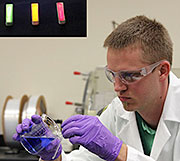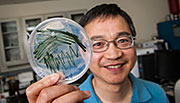- Number 453 |
- November 30, 2015
-
Software diagnoses battery health and remaining life
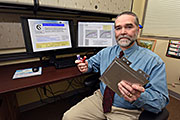 High-performing batteries are capable of propelling vehicles for hundreds of miles, storing electricity for the electric grid or running powerful electronic devices for several hours. A significant gap exists in knowledge about battery health, however, especially in how specific battery chemistries respond to usage conditions and different environments. These factors influence the degradation mechanisms, while also creating uncertainty in capacity and power (remaining useful life).
High-performing batteries are capable of propelling vehicles for hundreds of miles, storing electricity for the electric grid or running powerful electronic devices for several hours. A significant gap exists in knowledge about battery health, however, especially in how specific battery chemistries respond to usage conditions and different environments. These factors influence the degradation mechanisms, while also creating uncertainty in capacity and power (remaining useful life).
Kevin Gering, a researcher at DOE's Idaho National Laboratory, has developed an advanced software diagnostic tool to assess batteries currently in use. Known as CellSage (or Cell’s Age), this technology is able to characterize battery performance, diagnose the health of a battery in use, and predict how much longer it will be able to function in specific conditions and scenarios. -
Unstoppable, one-dimensional electron waves
 In certain nanomaterials, electrons are able to race through custom-built roadways just one atom wide. To achieve excellent efficiency, these one-dimensional paths must be paved with absolute perfection—a single errant atom can stop racing electrons in their tracks or even launch it backwards. Unfortunately, such imperfections are inevitable.
In certain nanomaterials, electrons are able to race through custom-built roadways just one atom wide. To achieve excellent efficiency, these one-dimensional paths must be paved with absolute perfection—a single errant atom can stop racing electrons in their tracks or even launch it backwards. Unfortunately, such imperfections are inevitable.
Now, a pair of scientists from Brookhaven Lab and Ludwig Maximilian University in Munich has proposed the first solution to such subatomic stoppage: a novel way to create a more robust electron wave by binding together the electron's direction of movement and its spin. The trick, as described in a paper published November 16 in Physical Review Letters and featured as an Editor's Selection, is to exploit magnetic ions lacing the electron racetrack. The theory could drive advances in nanoscale engineering for data- and energy-storage technologies. -
Record quality factor lowers cost of new particle accelerator
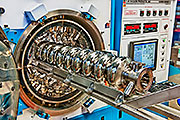 A team at DOE’s Fermi National Accelerator Laboratory achieved a record-high quality factor when testing the first fully dressed radio-frequency cavity built for a particle accelerator project at DOE’s SLAC National Accelerator Laboratory. The quality factor, Q, exceeded the goal for the Linac Coherent Light Source II project and far surpasses current state-of-the-art standards.
A team at DOE’s Fermi National Accelerator Laboratory achieved a record-high quality factor when testing the first fully dressed radio-frequency cavity built for a particle accelerator project at DOE’s SLAC National Accelerator Laboratory. The quality factor, Q, exceeded the goal for the Linac Coherent Light Source II project and far surpasses current state-of-the-art standards.
A higher Q means a cavity is more efficient at accelerating particles and loses less energy. It opens up a way for future particle accelerators to operate much more efficiently at a much lower cost.
LCLS-II will produce X-rays to probe a wide variety of materials at the nanoscale. Fermilab is responsible for designing, developing, building and testing about 150 nine-cell superconducting RF cavities for the LCLS-II accelerator. This was the first integrated test in which a nine-cell cavity was outfitted with all the components it will wear in the LCLS-II accelerator. -
Novel intermediate energy X-ray beamline opening for researchers
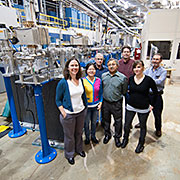 Researchers working to create next-generation electronic systems and to understand the fundamental properties of magnetism and electronics to tackle grand challenges such as quantum computing have a new cutting-edge tool in their arsenal. The Advanced Photon Source (APS), a DOE Office of Science User Facility located at Argonne National Laboratory, recently unveiled a new capability: the Intermediate Energy X-ray (IEX) beamline at sector 29.
Researchers working to create next-generation electronic systems and to understand the fundamental properties of magnetism and electronics to tackle grand challenges such as quantum computing have a new cutting-edge tool in their arsenal. The Advanced Photon Source (APS), a DOE Office of Science User Facility located at Argonne National Laboratory, recently unveiled a new capability: the Intermediate Energy X-ray (IEX) beamline at sector 29.
Using relatively low-energy X-rays, the IEX beamline at the APS will help illuminate electronic ordering and emergent phenomena in ordered materials to better understand the origins of distinct electronic properties. Another important feature for users is a greater ability to adjust X-ray parameters to meet experimental needs.
